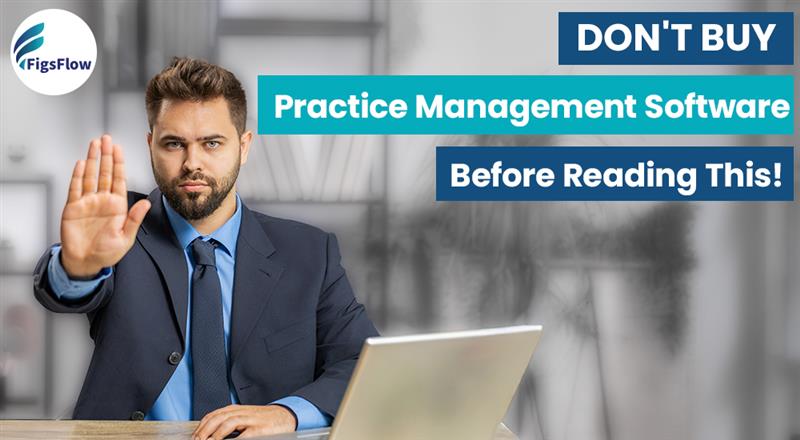An accountant got excited about the latest AI-powered practice management software. The marketing made it sound like a game-changer, and he invested hundreds of pounds and spent countless hours setting it up.
A week into the new system, he realised it was not much different than alternatives freely available in the market. Instead of boosting his productivity, the new software slowed him down, demanded more manual work and disrupted his entire workflow.
Now, the accountant is stuck digging through dozens of tools, overwhelmed and frustrated and unsure of which software will fit his firm’s needs.
If you don’t want to fall victim to a similar situation, you will want to read this article where you will get ten tips to help you find a practice management system (PMS) that suits your particular needs.
1. Start With Your Business Requirements
Before you start comparing practice management systems, be clear about what your practice needs are.
Ask yourself questions like:
- How do we invoice our clients?
- How do we assign and track work?
- Do we need integrated document sharing?
- Do we need client portals, e-signatures or secure messaging?
- Are there any specific workflows we must follow?
A solo practitioner may only need a simple task tracker and client database, while a multi-partner firm might need advanced scheduling, team collaboration and reporting tools.
Identify the bottlenecks that are slowing you down or causing missed deadlines. This will keep your focus sharp and help you pick the practice management system that solves your key problems.
2. Make Sure the Practice Management System Supports the Essential Functions of Your Practice
Now that you have identified what your accountancy practice truly needs, consider the practice management systems that can meet these essentials.
Focus on core areas that matter most to your practice and ask yourself, “How effectively does this system address my problem?”
For example, if you have identified delays in client communication as a bottleneck, check whether the system offers tools like secure messaging or client portals. If handling client data is a challenge, make sure the system provides safe and well-organised document storage and handling. Similarly, if you are facing issues with inconsistent proposal formats, look for a system that supports industry-specific proposals and workflows.
The right system is not the one with the most features. It’s the one that best supports the way you work. So, prioritise functionalities over features and choose the solution that will address your needs.
3. Choose A Software That Your Team Will Use
The best practice management software in the world won’t help you if your team struggles to use it. Look for software that is simple to understand and easy to move around.
Here’s a simple trick we often use to determine how easy-to-use the software is. Open the software and try to complete a basic task without referring to the manual or tutorials. If you cannot do it, it may be too complicated for everyday use.
Here are a few things you can watch out for:
- Are the menus and buttons clearly labelled?
- Is it easy to navigate the software?
- Does it take more clicks than you think it should to complete a basic task?
- Will new staff be able to learn it quickly?
Most software providers offer a free trial or a demo. Let a few team members try it out and give their honest feedback before you decide to move forward.
4. Check How Well the Software Integrates with Your Existing Tools
Most accountancy practices already have a variety of tools they use for tasks like tax filings, maintaining client records or emailing follow-ups. Your new practice management system should work well with these tools.
When your new system connects well with the tools that you already use, it saves time. You won’t have to enter the same information in more than one place. It also helps to avoid mistakes and keeps everything up to date.
But don’t just rely on the list of integrations shown on their website. Those lists often look good, but they don’t tell the full story. Take time to read customer reviews, especially the ones rated one, two or three stars. Look at what problems users had with integrations and how the company responded. That will tell you more about what to expect from the system.
5. Look for Automation Features to Simplify Routine Tasks
One of the major advantages of practice management systems is that they can automate routine tasks such as client onboarding, billing, proposal and engagement letter on your behalf.
So, start with the list of tasks you would like to automate, such as sending billing reminders, filling in common forms, assigning tasks to the right people, and sending email updates. Then, check how well the software can do it.
6. Make Sure the Software Helps You Stay Compliant
Regulations surrounding tax and accounting firms change frequently, and failure to comply often leads to serious consequences, including fines, penalties or even criminal charges in extreme cases.
So, choose a practice management system that helps you stay up to date and regulatorily compliant. You can look for features such as secure data storage, audit trails and proper record keeping. Also, consider the requirements of the General Data Protection Regulation (GDPR), local laws, and professional bodies such as ICAEW, ACCA, CIOT and others.
You can also ask the software provider how often they update the system to comply with new regulations. Take it a step further and check customer reviews to see if updates are done on time and if users are happy with how the software handles changes.
7. Make Sure the Software Can Grow with Your Practice
As your practice grows, your needs will change. You might hire more people, work with more clients or offer new services. Your system should be able to grow with you in a way that makes sense and stays affordable.
It is normal for costs to go up when you add more users or features. But the software should offer flexible upgrade options.
Also, make sure the software company is actively improving the product. They should regularly release updates, fix problems, and add helpful new features that match the needs of growing practices.
8. Evaluate the Quality of Support & Training
Find out what kind of help they offer. It may include an on-demand software demo, initial setup, and customer support via phone, chat or email.
These make your transition to the new system easier and fix problems quickly if anything goes wrong. Also, look for training materials such as live sessions, video guides or step-by-step instructions.
9. Check the Pricing Carefully & Make Sure It's Clear
Most software providers lure you in with low prices at first, but charge extra for important features or more users. Others use pricing plans that are hard to understand.
So, before you sign up, understand the total cost of the software. This should include licenses, setup charges, support fees, and any limitations. Make sure you know what’s included and what’s not.
Compare the different pricing options to see which one gives you the best value. The right practice management system should fit your budget and be clear about what you are paying for.
10. Choose a System That Offers a Secure Client Portal
Make sure the client portal is secure. You can look for features such as data encryption and secure login options to protect client information. This is particularly important if you are dealing with private tax or accounting data.
A good client portal helps your firm look more professional and keeps things organised. It also gives your clients a simple and safe way to work with you.
Conclusion
With countless tools offering identical features at similar prices, choosing the right practice management system can feel confusing and overwhelming.
So, lead with your firm’s needs. Look for a system that fits your workflow and solves real problems.
You can review customer reviews, explore integration options, pricing plans, and accreditation to narrow the software list to the top three or four options. Then, take a demo and test the software with real work.
And most importantly, don’t go with someone else’s recommendation. You already know that path and where it leads.


